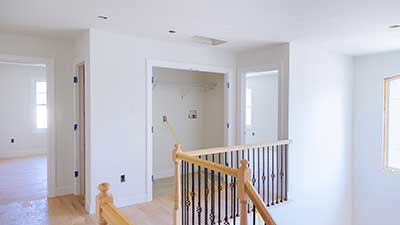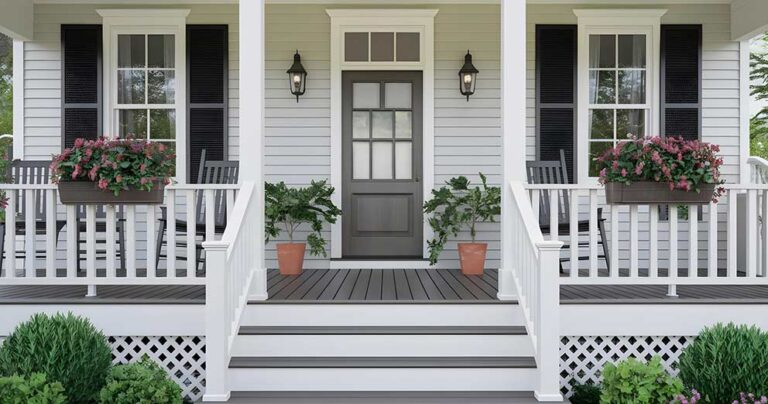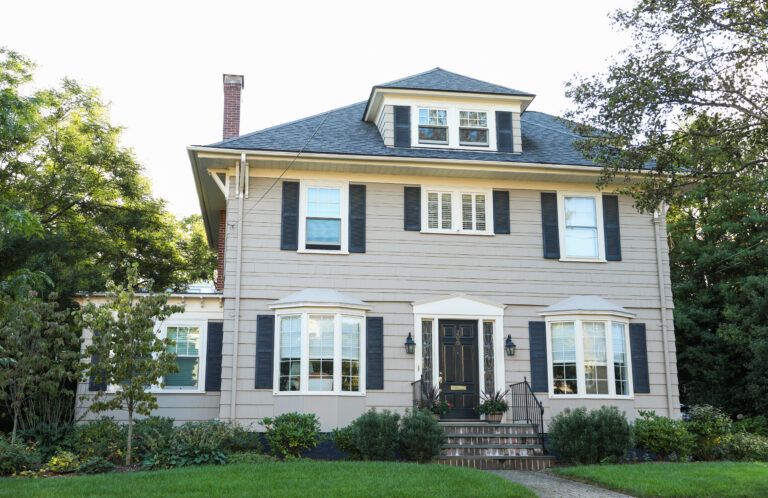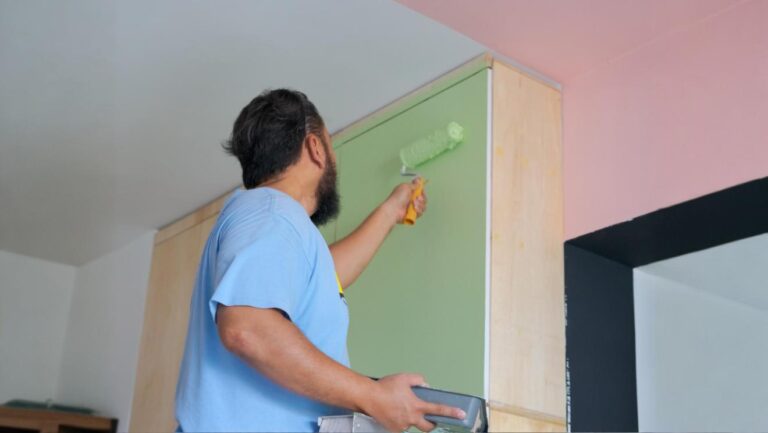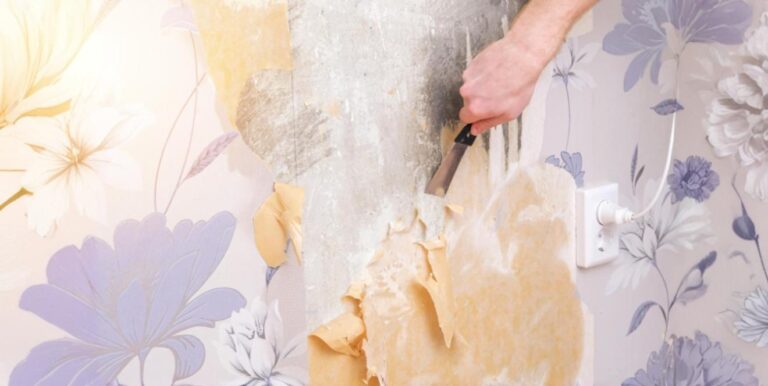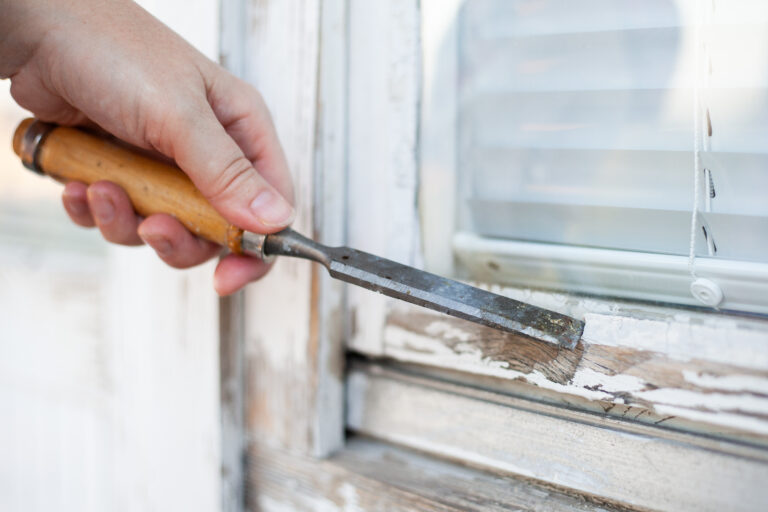Painting over stained wood doesn’t have to be complicated, but it does require specific steps to get lasting results. Whether you’re updating old furniture or refreshing trim throughout your home, this guide will walk you through everything you need to know about transforming stained surfaces with paint. With the right approach, you can achieve professional-looking results without having to strip all the stain first.
Key Takeaways
- Successfully painting over stain requires proper surface preparation to help the paint adhere correctly to the wood.
- You can paint over stained wood without sanding by using liquid sandpaper or a chemical deglosser to rough up the existing finish.
- Oil-based primers provide the best protection against bleed-through when covering dark stains or woods with high tannin content.
- Most painted wood surfaces need at least two coats of paint over primer for complete coverage of the previous stain.
- Old stain and clear coats must be properly deglossed before applying new paint to prevent peeling and flaking.
- For professional-looking results on large or complex stained wood projects, consider hiring specialists like OnDemand Painters who have the right equipment and expertise.
What Happens If You Paint Over Stain?
When you paint directly over stained wood without proper preparation, several problems can occur. The most common issue is poor adhesion – your new paint simply won’t stick well to the glossy surface of stained wood. This leads to peeling, chipping, and a finish that looks amateur rather than professional.
Another major problem is bleed-through. Wood stains contain dyes and pigments that can work their way through your new paint, creating discoloration and uneven patches. This happens because most stains, especially oil-based ones, have chemicals that remain active long after application and can penetrate through regular paint.
The type of stain matters significantly. Oil-based stains require different preparation than water-based stains. Oil-based stains create a more water-resistant surface that paint struggles to adhere to. Water-based stains are typically easier to paint over but still need proper preparation for the best results.
The existing finish on your stained wood also plays a major role. If the wood has a clear coat like polyurethane, varnish, or shellac, you’re not actually painting over the stain – you’re painting over the clear protective layer. This glossy surface needs special attention before paint will stick properly.
Can You Paint Over Stained Wood Without Sanding?
This is one of the most common questions about painting stained wood. Everyone wants to skip sanding – it’s dusty, time-consuming, and frankly, not fun. The short answer is: technically yes, but with important conditions.
You need to create a surface that paint can grab onto. While traditional sanding with sandpaper works best, you can use a chemical deglosser (also called liquid sandpaper) instead. Products like Klean-Strip Liquid Sandpaper work by chemically etching the surface, breaking down the glossy finish that prevents paint adhesion.
Remember that liquid sandpaper contains strong chemicals. You must work in a well-ventilated area and wear protective gloves and a respirator. The fumes can be harmful, so proper ventilation is essential. Many professionals use liquid sandpaper for tight corners and detailed areas, then use actual sandpaper for larger, more accessible surfaces.
If you try to paint stained wood without either sanding or using a deglosser, you’re setting yourself up for failure. The paint will likely peel within months or even weeks. Taking this shortcut almost always leads to redoing the entire project – which means more time and money spent than if you’d just prepared the surface properly the first time.
For wood in good condition with a light stain, a thorough cleaning and light scuff sanding with 150-220 grit sandpaper may be sufficient. You don’t need to remove all the stain – just rough up the surface enough for the primer to adhere properly.
What Kind of Paint Do You Use Over Stain?
Choosing the right paint for stained wood depends on several factors, including the type of stain you’re covering and the look you want to achieve.
For most interior projects, high-quality latex paint works well over properly primed stained wood. Latex paint dries quickly, has low VOCs (volatile organic compounds), and cleans up easily with water. When painting over water-based stains, latex paint with a latex primer is often the best choice.
Oil-based paint remains popular for certain applications because it creates a hard, durable finish that stands up well to heavy use. When painting over oil-based stain, using an oil-based paint with an oil-based primer provides excellent adhesion and durability. The downside is stronger fumes, longer drying time, and cleanup that requires mineral spirits.
The most critical factor in painting over stain isn’t actually the paint – it’s the primer. You need a stain-blocking primer designed to seal in the stain and prevent bleed-through. For tough stains or dark colors, shellac-based primers like Zinsser B-I-N provide superior stain blocking. For lighter stains, a good oil-based primer or water-based stain-blocking primer will usually work fine.
When choosing paint for high-traffic areas like floors, cabinets, or furniture, consider specialty paints designed for durability. Cabinet and furniture paints contain hardeners that create a tougher finish than standard wall paint.
Can You Paint Over Solid Wood Stain?
Yes, you can paint over solid wood stain. Solid stains are more like thin paints than traditional penetrating stains. They sit on the surface rather than soaking deeply into the wood grain, which makes them generally easier to paint over than transparent or semi-transparent stains.
The preparation process for solid stains follows the same principles as other stained surfaces. You’ll need to clean the surface thoroughly to remove dirt and oils that could interfere with adhesion. Since solid stains typically have a slightly rough texture already, light sanding with 150-grit sandpaper usually creates enough texture for primer to grip.
One advantage when painting over solid stain is that bleed-through is less common than with penetrating stains. The solid stain creates a barrier that helps contain the pigments. However, you should still use a good primer to ensure the best adhesion and coverage.
If your solid-stained surface is exterior wood that has been exposed to the elements, check carefully for damaged areas. Scrape away any flaking or peeling stain before painting. Any stain that’s loose now will take your new paint with it when it eventually comes off.
How to Paint Over Stained Wood – Step by Step
Successfully painting over stained wood requires following a specific process. Here’s a step-by-step guide that works for furniture, trim, cabinets, and other stained wood surfaces:
Step 1: Clean the wood thoroughly. Use trisodium phosphate (TSP) cleaner to remove dirt, grease, and oils from the surface. TSP works particularly well for kitchen cabinets that may have cooking residue. For less grimy surfaces, a gentle all-purpose cleaner will work. Rinse the surface with clean water and let it dry completely.
Step 2: Prepare the wood surface. Remove any hardware such as knobs, hinges, or pulls. Fill any holes, dents, or scratches with wood filler and let it dry completely before sanding. For furniture in bad shape, auto body filler provides a more durable repair for larger damage.
Step 3: Sand or degloss the surface. Create a rough texture for the primer to grip using 150-grit sandpaper. If you’re working with intricate details or tight corners, liquid sandpaper (deglosser) is helpful. You don’t need to remove all the stain – just rough up the glossy finish. After sanding, clean all dust with a tack cloth.
Step 4: Apply stain-blocking primer. Choose a primer designed for your specific situation. For most stained wood, a high-quality stain-blocking primer works well. For dark stains or woods with tannins (like cedar or redwood), use a shellac-based primer, which provides the strongest seal against bleed-through. Apply the primer evenly with a brush, roller, or sprayer.
Step 5: Let the primer dry completely. Follow the manufacturer’s instructions for drying time. In most cases, this takes about an hour, but longer is better. Once dry, lightly sand the primer with 220-grit sandpaper to create a smooth surface, then wipe away dust with a tack cloth.
Step 6: Apply the first coat of paint. Use a high-quality brush, foam roller, or sprayer. Work in small sections and maintain a wet edge to avoid lap marks. Let the first coat dry completely – usually about two hours for latex paint or longer for oil-based paint.
Step 7: Sand lightly and apply second coat. For the smoothest finish, lightly sand between coats with 220-grit sandpaper, then wipe with a tack cloth before applying the second coat. Most projects require two coats of paint for complete coverage, but dark stains or bright new colors may need a third coat.
Step 8: Reassemble and enjoy. Once the final coat is completely dry, reinstall any hardware and put your newly painted piece back in use. Wait at least 24 hours before placing items on freshly painted surfaces.
Common Problems When Painting Over Stained Wood
Even with careful preparation, you might encounter challenges when painting stained wood. Knowing how to address these common problems can save your project.
Bleed-through is the most frequent issue – those annoying yellowish or pinkish stains that appear in your fresh paint. This happens when the stain’s pigments or the wood’s natural tannins seep through your primer and paint. The solution is to apply another coat of stain-blocking primer (shellac-based works best) directly over the affected areas, then repaint.
Adhesion problems show up as peeling or bubbling paint. This typically means the surface wasn’t properly prepared. If you catch it early, sand down just the affected areas, apply primer, and repaint. For widespread problems, you may need to strip the paint and start over with more thorough preparation.
Brush marks and roller texture can ruin the smooth finish you want. For furniture and cabinets, consider using a paint additive like Floetrol for latex paints or Penetrol for oil-based paints. These products slow drying time, allowing brush marks to level out. Alternatively, spraying provides the smoothest finish for large or detailed projects.
Uneven color coverage often happens when painting light colors over dark stains. The solution is simple but time-consuming – apply additional coats of paint until the color is consistent. Starting with a tinted primer close to your final color can reduce the number of topcoats needed.
Tips for Painting Different Types of Stained Wood
Old wood presents unique challenges when painting. Years of exposure can leave wood dry and porous, which means it will absorb more primer and paint. Start by cleaning thoroughly and address any rot or damage before proceeding. Old wood often benefits from an oil-based primer, which penetrates deeply and seals the surface well.
For stained furniture, remove all hardware and work on a flat surface when possible. Fill old hardware holes if you’re planning to use new hardware in different locations. Furniture with intricate details may benefit from spray painting rather than brushing to avoid paint buildup in corners and crevices.
Cabinets require special attention because they endure frequent use and cleaning. Cabinet-specific paints like Benjamin Moore Advance or Sherwin Williams ProClassic are worth the investment. These paints cure to a harder finish that resists chipping and can withstand repeated cleaning.
Trim and molding with years of built-up finish may need extra deglossing. Pay special attention to edges and detailed profiles where finish tends to accumulate. For trim with multiple layers of old paint or varnish, consider using a palm sander to speed up the preparation process.
When to Call Professional Painters
While painting over stained wood is definitely a DIY-friendly project, some situations warrant calling professionals. Complex projects like kitchen cabinets, built-ins, or whole-house trim packages often benefit from professional expertise and equipment.
Professional painters like OnDemand Painters have access to commercial-grade sprayers that create a factory-like finish impossible to achieve with brushes and rollers. They also have the experience to anticipate and prevent problems before they occur.
For valuable antiques or heirloom pieces, professional refinishers bring specialized knowledge about different wood types and historical finishes. The investment in professional services often pays off through superior results and longer-lasting finishes.
If your project involves lead paint (common in homes built before 1978), professionals have the proper certification and equipment to handle this safely. DIY removal of lead paint can create serious health hazards for your family.
Conclusion
Painting over stained wood transforms spaces and furniture with relatively modest investment. The key to success lies in proper preparation – cleaning, sanding, and priming correctly before applying paint. With attention to these details, your painted wood can look professional and last for years.
For those who don’t have the time, tools, or confidence to tackle painting stained wood themselves, services like OnDemand Painters provide professional results without the hassle. Whether you DIY or hire pros, understanding the process helps ensure you get the outcome you want from your project.
Remember that different woods and different stains require slightly different approaches. Take the time to assess your specific situation, gather the right materials, and follow the steps outlined here. The extra effort in preparation will be rewarded with a beautiful, durable finish that stands the test of time.
FAQs
Can you paint over stain?
Yes, you can paint over stain as long as you properly prepare the surface first with cleaning, light sanding, and applying the right primer.
How do you prepare bare wood before painting over stain?
Clean the bare wood thoroughly, sand lightly with fine-grit sandpaper, and apply a stain-blocking primer designed for raw wood surfaces.
What should you do with existing stain before painting?
Lightly sand or degloss the existing stain to create a rough surface that will help the primer and paint adhere properly.
Is bonding primer necessary when painting over stained surfaces?
Bonding primer is highly recommended as it creates a strong foundation between the stained surface and your new paint.
Is one coat of paint enough when covering stain?
One coat is rarely sufficient – most projects require at least two coats of paint over primer for complete coverage and durability.
Can water based paint be used over oil-based stain?
Water based paint can be used over oil-based stain, but only after applying the appropriate oil-based primer first to prevent adhesion problems.
Will the original stain color affect my final paint color?
Yes, dark stain colors may require additional primer and paint coats to prevent the original stain color from affecting your final paint color.









